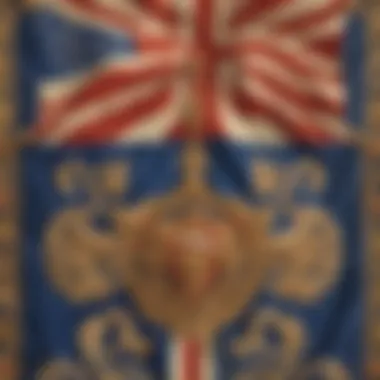Exploring the Cultural Significance of Flags Worldwide


Intro
Flags are more than just pieces of fabric; they are potent symbols that convey the essence of a nation. Every flag tells a story—a narrative woven with threads of history, culture, and identity. As they flutter in the wind, flags represent the ideals, struggles, and aspirations of the people they signify. For many, the sight of their national flag evokes a sense of pride and belonging, a reminder of their heritage and unity.
In this article, we will explore how flags across the globe reflect the unique characteristics of their corresponding countries. This journey into vexillology, the study of flags, includes not only their designs and colors but the meanings imbued in those choices. From the bold stripes of the United States to the intricate patterns of Bhutan, each flag serves as a canvas, painting a picture of its nation’s values and history.
As we dive deep into this rich tapestry, we’ll uncover:
- The cultural significance of select flags and the history behind them.
- The design elements that make each flag distinctive.
- Regional variations and historical transitions that shape how flags are perceived today.
- The role these symbols play in international relations.
By the end of this exploration, readers will not only appreciate the aesthetics of flags but also grasp the importance of these symbols in understanding national identity.
Prologue to Flags and Their Importance
Flags serve as a poignant representation of a nation's identity, encapsulating culture, history, and values within a colorful canvas. The relationship between flags and their countries is not just one of design, but of meaning. Each flag tells a story, bridging past and present, while unifying people under shared ideals. This article embarks on a journey to explore the significance of flags, their intricate components, and their role in shaping national pride.
Understanding the importance of flags equips us with insights into how countries communicate their essence. It teaches us to appreciate the diverse symbology found in colors, shapes, and patterns, which often reflect a nation's rich history and cultural evolution. Moreover, flags promote patriotism and serve as rallying points during times of celebration and distress. They are raised high during festivals and international gatherings, reminding us of what makes a nation unique.
The exploration of flags is also instrumental in fostering global awareness. By delving into the stories behind flags across various continents, we uncover the interconnectedness of cultures and histories. For instance, it can be fascinating to discover that the red, white, and blue of the USA’s Stars and Stripes echo values emblematic of revolution and freedom, resonating with other nations that have undergone similar transformations.
Understanding Vexillology
Vexillology, a term not often heard in everyday conversation, is the study of flags and their symbolism. This discipline encompasses not only the design of flags but also their meanings and usages in various contexts. Engaging with vexillology invites us to appreciate the artistry and intention behind flag formation. Each element of a flag has been carefully chosen, as it is meant to convey particular traits associated with that nation—be it unity, bravery, or peace.
In recent years, vigorous discussions around vexillology have emerged, particularly as countries reassess their national identities. Whether it's Portugal considering updates to its flag design or the United Kingdom debating the future of the Union Jack, examining these dialogues unveils how critical flags are to national conversations.
"A flag is more than just a piece of cloth; it is the heart of a nation, painted in the colors of its spirit."
Historical Significance of Flags
Historically, flags originated as military standards, identified armies on the battlefield and distinguished allies from foes. As civilizations evolved, so did the meanings attributed to their flags. The history of flags is woven into the very fabric of human progression—from the Roman legions using vexilla to modern states adopting banners that symbolize new governance and alliances.
In some instances, flags evolved after significant events, such as revolutions or independence movements. For example, after Brazil gained independence from Portugal in 1822, its flag was redesigned to embody a sense of nationalism, showcasing the transition from colonial rule to self-determination. The current flag reflects Brazil's vast biodiversity and its historical roots, adorning the national landscape with pride.
The story of each flag is often reflective of broader societal changes. These historical flags are reminders of struggles faced, values fought for, and victories celebrated. As we look at the flags that adorn our map, we witness not only geographical boundaries but strokes of stories that continue to shape our world today.
In summary, flags are far more than decorative pieces; they are symbols imbued with meanings that resonate deeply within societies. Understanding the significance of flags broadens our awareness, inviting us to appreciate the diverse narratives interwoven with national identities.
Components of a Flag
Understanding the components of a flag is like peeling back the layers of an onion; each layer reveals more about the identity and values of a nation. Flags are not mere pieces of fabric; they embody profound significance and convey narratives reflective of the countries they represent. From the colors chosen to the shapes that adorn them, every element plays a distinct role in communicating national pride and history. Therefore, examining these components allows us to appreciate flags as vital symbols in our global landscape.
Colors and Their Symbolism
Colors in flags are not arbitrary choices; they are infused with meaning and symbolism that transcend linguistic barriers. In many ways, a flag's color scheme serves as a visual language that tells stories about a nation's past, beliefs, and aspirations. For instance:
- Red commonly represents valor and bravery. Countries like China and Canada harness this hue to symbolize their fighting spirit and willingness to stand up for their values.
- White often signifies peace and purity, as seen in the flags of Japan and France, where it conveys a sense of hope and harmony.
- Blue can reflect various ideas: it stands for justice in the U.S. flag, while in the flag of Argentina, it invokes a connection to the sky and water, signifying the land's natural beauty.
Through these colors, nations communicate their essence, values, and even their challenges. A flag’s color palette can be seen as a distilled reflection of common experiences and shared belief systems.
Shapes, Patterns, and Emblems
Shapes and patterns further enrich the symbolism behind flags. They serve not just as adornments but as signifiers of national character. The different arrangements and designs create a tapestry of meanings. For example:
- Stripes in the flag of the United States represent unity among the states, with each stripe corresponding to a different origin. Similarly, the stripes of the *flag of France embody the principles of liberty, equality, and fraternity.
- Crosses found in flags like that of England and Sweden indicate a historical connection to Christianity, revealing aspects of the cultural and religious foundations of these nations.
- Emblems often encapsulate national identity, such as the eagle on the Mexican flag, which draws from ancient mythology to convey strength and resilience.
The design of a flag can stir emotions, evoke memories, and instill a sense of belonging among a population.
In essence, the components of a flag — from colors and shapes to patterns and emblems — work in unison to weave a narrative deeply rooted in cultural identity and historical context. By analyzing these elements, we can gain a profound appreciation for how flags serve as powerful symbols that reflect the shared stories of their nations.
Flags by Continent
The section on flags by continent is crucial, as it sheds light on how geographic context influences the design, color schemes, and symbols used on flags. Different regions of the world have unique histories and traditions, which are often visually represented in their flags. By examining flags through this lens, we can gain insights into global diversity and the shared values that unite various nations. This section will guide readers through the flags of Africa, Asia, Europe, North America, South America, and Oceania, highlighting not just their imagery but also the stories they tell.


Flags of Africa
African flags often embody the spirit of independence and the continent's rich tapestry of cultures. The colors frequently represent significant ideas: for example, green denotes the lush landscapes and agricultural potential, while red may symbolize the blood shed in the struggle for freedom. Take the flag of Ethiopia, which features horizontal stripes of green, yellow, and red, accompanied by a blue emblem—symbolizing peace, freedom, and the unity of the African people.
Some flags are more than just national symbols; they tell stories of resistance and unity. For instance, the flag of Mozambique features an AK-47 and a hoe, reflecting the country's fight for liberation and commitment to agricultural development. This duality highlights how flags capture the essence of a nation's narrative.
Flags of Asia
Asia is incredibly diverse, and its flags reflect this melting pot of cultures and traditions. The flag of Nepal is unique in its shape, consisting of two stacked triangles. Its crimson red and deep blue symbolize bravery and peace, respectively. Moreover, the sun and moon depicted on the flag signify hope for longevity and stability.
In contrast, the simple yet striking design of Japan’s flag—a red circle on a white background—captures the notion of purity and simplicity that is deeply rooted in Japanese philosophy. Each flag in Asia tells a tale of its people, history, and aspirations.
Flags of Europe
European flags often reflect historical conflicts and unity. For example, the flag of the European Union, with its circle of stars, symbolizes solidarity among member nations. It’s a modern emblem of cooperation that arose from the ashes of past wars. Then there's the Union Jack, representing England, Scotland, and Northern Ireland; its complicated design reflects the union of these nations throughout history.
The design of the flag of Greece stands as a vivid reminder of the country's classical heritage. The blue and white stripes symbolize the waves of the Aegean Sea and the sky above, while the cross is emblematic of the Greek Orthodox faith. Each European flag serves as both a reminder of history and a banner for the future.
Flags of North America
North American flags present a combination of colonial heritage and indigenous symbols. The Stars and Stripes of the United States, with its iconic red, white, and blue, tells a story of revolution and unity among diverse states. The 50 stars symbolize the states, while the stripes represent the original thirteen colonies.
Canada's flag, with its simple yet striking red maple leaf, showcases a national identity rooted in nature and inclusivity. The choice of the maple leaf reflects a broader cultural appreciation for biodiversity and the environment found within Canadian borders.
Flags of South America
In South America, flags often display vibrant colors and motifs linked to indigenous cultures and colonial histories. The flag of Brazil, with its green field and yellow diamond, represents its lush rainforest and mineral wealth. The blue globe in the center holds stars that depict the country’s constellations, symbolizing national unity and aspiration.
The flag of Colombia carries a tricolor with yellow symbolizing the wealth of the land, blue for the seas, and red for the blood spilled during the struggle for independence. Such flags not only serve as national icons but also act as a canvas for the stories of resilience and hope.
Flags of Oceania
Oceania’s flags are rich in symbolism and deeply connected to the ocean and indigenous cultures. The flag of New Zealand, with its British Blue Ensign and Southern Cross, highlights the country’s colonial past while embracing its Pacific identity. The Southern Cross constellation echoes the region's navigation and exploration heritage.
Similarly, the flag of Fiji incorporates symbols of the island's indigenous heritage, showcasing a shield with the Union Jack. It acts as a reminder of the country’s history and current cultural identity.
By delving into the flags of each continent, we not only gain an understanding of design and colors but also cultivate an appreciation for the diverse stories that shape each nation's identity.
Notable Flags and Their Stories
Exploring notable flags and the tales behind them serves as a gateway into understanding the intertwined narratives of identity, culture, and history. These flags do not simply flutter atop poles; they carry profound significance, encapsulating the very essence of nations and their collective experiences. Each flag embodies a story, from its design elements to the events that shaped its existence. Discovering these stories helps us appreciate the flags not just as symbols, but as representations of national pride and resilience.
The Union Jack and Its Legacy
The Union Jack, the national flag of the United Kingdom, weaves together the flags of England, Scotland, and Ireland, forming a striking and recognizable design. It is a symbol of unity, representing the amalgamation of different cultures and histories into a single entity. The origins of the Union Jack can be traced back to the early 17th century when King James VI of Scotland united the crowns of England and Scotland.
One must consider how the flag has evolved over time. Originally, it was used primarily for naval purposes. Today, however, it appears in various settings, symbolizing British identity across the globe. The incorporation of the cross of Saint George, representing England, the saltire of Saint Andrew, denoting Scotland, and the slight addition of the cross of Saint Patrick for Ireland, brings layers of meaning to the flag.
"A flag is a mile marker on the road of history."
The Stars and Stripes: Symbolism and History
The flag of the United States, known popularly as the Stars and Stripes, is steeped in symbolism that a lot of people might not realize at first glance. Comprising thirteen stripes representing the original colonies and fifty stars symbolizing the current states, this flag echoes the journey of a nation’s growth from a handful of territories to a global powerhouse. Adopted in 1777, its design has been a point of contention and pride throughout American history.
The scenarios in which the Stars and Stripes have been displayed have added more chapters to its narrative. From soaring over battlefields during wars to being carried at sporting events and parades, it evokes emotions of patriotism, sacrifice, and hope. The flag's hues—red, white, and blue—carry their own meaning as well: red signifies valor, white symbolizes purity and innocence, while blue represents vigilance, perseverance, and justice. This rich tapestry of meaning reflects the beliefs held by those who identify with it.
The Flag of India: A Journey Through Time
The national flag of India, known as the Tiranga, stands as a vibrant representation of the country's struggle for independence and its aspirations for the future. Its unique design consists of three horizontal stripes: saffron at the top, white in the middle, and green at the bottom, along with a navy blue Ashoka Chakra at the center. Each color is deeply symbolic; saffron signifies sacrifice and courage, white represents truth and peace, and green indicates faith and chivalry.
The flag's history is a reflection of India’s tumultuous path to freedom. Adopted in 1947, it encapsulates nearly two centuries of struggle against colonial rule and the hope of a new beginning. Moreover, the Ashoka Chakra represents the eternal wheel of law, emphasizing justice and righteousness. When you look upon this flag, you are gazing at a symbol of democracy, a nation’s resilience, and its commitment to uphold values that are integral to its identity.
Flag Etiquette and Usage
Flag etiquette is more than just a set of rules; it's a profound expression of respect and reverence for the national symbols that unify a country. A flag often stands as a beacon of identity, original history, and culture. Thus, knowing the proper way to display these symbols is essential—not just for individuals or organizations but for fostering a deeper understanding of national pride among children, parents, teachers, and caregivers alike.


Displaying Flags Properly
When it comes to displaying flags, there’s a right way and a wrong way. Here are key points to consider:
- Positioning: A flag should always be positioned at a place of honor, such as the highest point on a flagpole or a designated area within the home. When displayed with other flags, it should fly higher than all others, or if equal, should be on the left side (the viewer’s perspective).
- Light it Right: If a flag is flown at night, it should be illuminated. A bright light adds dignity, reflecting the importance of the emblem. Without proper lighting, it's considered disrespectful.
- Weather Considerations: Flags made of various materials have different resistance levels. For example, cotton flags can get easily damaged in harsh weather. Make sure to take it down during storms, heavy rain, or snow, as faded or torn flags can signal abandonment and disrespect toward the nation.
- Drape with Care: When used in events like parades or ceremonies, the flag should never touch the ground. Wrapping it around someone as a cape, no matter how cute it looks, goes against etiquette.
"The flag flies not just for a government or a group; it is a testament to the citizens' unity and values, and it requires treatment that reflects its significance."
These simple actions create a culture of respect and acknowledgment towards the emblem that flutters proudly. Parents and teachers can play an integral role here by instilling these values into the younger generation.
Flag Protocol in Different Countries
Flag protocol varies across nations, showcasing a delightful tapestry of cultural practices regarding this significant symbol. Here are some notable differences:
- United States: The U.S. Flag Code is pretty explicit about its usage. For example, it must be displayed during daylight hours unless it’s illuminated. Flags should not be displayed in a manner that allows them to touch the ground.
- Japan: The Nisshoki, or the Japanese flag, is displayed at important occasions but isn’t as commonly used for everyday events. Respect for the flag is pervasive, and no one should ever misuse or disrespect it.
- Brazil: Brazil's flag comes with its own set of colorful traditions. It’s customary to show the flag at national celebrations, like Independence Day. Yet, it shouldn’t be flown after sunset unless lit up.
- Scotland: The Saltire, or St. Andrew’s Cross, is treated with great reverence. When displayed with other flags, it follows a specific order, and it's an offense to let it touch the ground.
Understanding these diverse customs enhances children's appreciation of flags globally, enabling rich dialogues about respect and traditions. Creating room for conversations around such topics opens avenues not just for knowledge but builds character as well.
The Role of Flags in Global Events
Flags often act as powerful symbols in the context of global events, representing nations and their ideals during significant moments. This section will delve into how flags reinforce national identity and foster unity, particularly during events such as diplomatic gatherings, international summits, and sporting competitions. Understanding the influence of flags in these contexts allows us to appreciate their role beyond mere fabric; they embody heritage, aspiration, and sometimes even conflict.
International Relations and Flags
Flags in international relations carry a weighty significance. When nations engage in diplomacy, their flags are prominent, serving as identifiers of their sovereignty and a reminder of their unique cultures.
- Diplomatic Engagements: At high-profile meetings like the United Nations General Assembly, flags are displayed prominently. Each flag is a declaration of a country's presence, indicating their participation in dialogue and decision-making.
- Symbol of Unity: During treaties and agreements, the shared display of flags symbolizes unity and collaboration among nations. Picture a summit where world leaders convene; the flags represent the collective effort to solve pressing global issues, such as climate change or humanitarian crises.
- Cultural Exchange: Flags also pave the way for cultural exchange. Events like international festivals or cultural showcases invite nations to display their flags, fostering an environment where cultures intermingle.
"A flag is not just a piece of cloth; it is the soul of a nation, a visual thread connecting generations."
Flags in Sports and Competitions
Sporting events, especially the Olympic Games or the FIFA World Cup, amplify the role of flags. Athletes carry their flags with pride, representing not just themselves but their entire nation.
- National Pride: The sight of national flags being waved in a stadium can evoke immense pride. It’s a visual manifestation of support, creating a bond between athletes and their spectators.
- Rivalry and Unity: Flags also stir emotions of rivalry, particularly during competitions like the Olympics. The thrill of competing nations, each with their colors flying high, adds an extra layer of excitement.
- Celebration of Identity: Medal ceremonies, where athletes stand proudly with their flags, symbolize a nation’s hard work and achievements. The anthem plays, the flag rises, and in those moments, it encapsulates the essence of national identity, often bringing communities together in celebration.
In summary, the role flags play in global events cannot be overstated. They serve as important symbols in international relations, and their presence in sports fosters a sense of camaraderie and competition among nations. Flags provide a visual shortcut to understanding a country’s identity, its aspirations, and its history, weaving a narrative of connection across the globe.
The Evolution of Flag Designs
The evolution of flag designs is a fascinating journey that reflects the changing identities and values of nations across history. Flags have transformed from simple, rudimentary symbols to intricate designs with complex meanings. Understanding this evolution allows us to appreciate how flags are not just pieces of fabric but embodiments of each nation's stories, beliefs, and aspirations.
Historical Changes in Flags
Flags have potential social and political power, serving as rallying points during times of conflict and unity. Initially, flags were utilitarian tools for identification in battles and gatherings. They often featured basic designs with prominent colors to stand out in the chaos of warfare. For instance, in the medieval era, knights would hoist banners displaying their heraldic symbols, which communicated alliance and ownership of land.
As countries formed and began to assert their identities, flags evolved significantly. The American Revolution saw the adoption of the Stars and Stripes, incorporating elements of unity among thirteen colonies. This flag not only represented independence but also the emerging concept of a republic—a significant shift from monarchy to democracy.
Different regions embraced distinct changes in flag designs, too. The flags of European nations in the 19th century often underwent drastic alterations during periods of revolution, as seen in the flags of countries like France and Germany. These symbols shifted from royal emblems to incorporate ideas of liberty and national pride, a reflection of the people's aspirations.
"Flags serve as mirrors reflecting the cultural and historical narratives of the societies they represent. Understanding these changes is crucial for grasping their impact on national identity."
Modern Flag Design Trends
In the present day, flag designs continue to evolve, influenced by globalization, technology, and shifting social attitudes. Modern flags show a lean towards minimalism, concentrating on symbolism and clarity rather than ornate images. The use of flat colors and geometrical shapes can make flags more recognizable from a distance, essential for both domestic use and international representation.
Moreover, there's a growing trend to include diverse and inclusive elements. In some new flags, colors and patterns represent different ethnicities or social movements, suggesting a move toward flag designs that embrace the complexities of national identities. An example is the flag of South Africa, designed post-apartheid, which integrates multiple colors and shapes representing unity among its diverse population.
Flags are also seeing their meanings expand in light of contemporary issues. Many nations are rethinking their symbols to reflect modern values, such as sustainability and peace, as observed in recent proposals for flag redesigns based on ecological responsibility.
To conclude, the evolution of flag designs encapsulates not only the history of the nations but also the dynamic nature of identity itself. As societies continue to evolve, their flags will likely be at the forefront, representing the values and narratives of their people.
Cultural Impact of Flags
The profound cultural impact of flags extends well beyond their physical representation of nations. Flags symbolize unity, heritage, and the values that a country upholds. They serve as articulations of collective identity, embodying the essence of a nation's spirit. Seeing a flag can evoke a sense of belonging, prompting individuals to connect with a larger story—one steeped in history, tradition, and aspirations.


Flags play significant roles in various aspects of culture, serving not only as decorative pieces but as profound communicators of social and political narratives. Countries adopt certain colors and designs not by mere chance, but through deep historical ties and shared values among their people. For instance, the green color in the flag of Mexico is a representation of its lush landscapes and deeply held beliefs, while in the flag of South Africa, the multicolored pattern symbolizes unity in diversity.
Moreover, flags contribute to a nation's mythology and folklore. Citizens may recall tales passed down through generations, linking their past struggles or victories to the symbolism embedded in their flag. Through artistic expression, flags also find homes in literature, music, and other cultural artifacts.
"Flags are the epitome of a nation’s identity, a living legacy of its past and the aspirations it holds for the future."
Flags in Art and Literature
Flags have been crucial influences in art and literature, serving as powerful symbols that convey emotions and narratives. In contemporary art, many artists utilize flags in their work to critique political systems or celebrate cultural diversity. For example, Jasper Johns famously painted the American flag, investigating its role in American identity and its optical qualities, prompting viewers to reflect on their own perceptions of patriotism.
In literature, flags often symbolize more than mere national identity. They represent freedom, rebellion, and the struggle against oppression. The flag in George Orwell's 1984 emerges as a constant reminder of an all-seeing government. Authors weave flags into their narratives to evoke patriotism or challenge the status quo, prompting readers to ponder their own beliefs.
Additionally, the act of flag raising often finds its representation in many literary works, signifying the rise of hope and victory in the face of adversity. Writers and poets have used flags metaphorically, portraying them as markers of triumph or defeat throughout human history.
The Flag as a Symbol of Resistance
Flags also serve as potent symbols of resistance and defiance. Throughout history, subdued populations have adopted flags to claim their identity and assert their rights. An iconic example is the usage of the Palestinian flag, which has become a symbol of the people’s fight for recognition and sovereignty in a conflict-ridden region. Such flags become rallying points for communities, representing their collective desire for autonomy.
Furthermore, flag symbolism has evolved with social movements around the world. The rainbow flag, originally designed as a symbol for the LGBTQ+ community, has transformed over time into a beacon of diversity and acceptance. By raising such flags, communities signal their presence and demand acknowledgment in socio-political landscapes.
Flag Recognition and Learning Tools
Recognizing flags is more than just identifying colorful pieces of fabric; it weaves a thread of connection to a country's history, culture, and values. The importance of flag recognition tools lies not only in educational contexts but also in enriching one’s global awareness.
When children learn about flags, they don’t just memorize colors and patterns. They engage with stories about nations and their people. Educational resources help shape a foundational understanding of geography, politics, and cultural diversity. Furthermore, they provide context—why a flag holds significance and the values it embodies, from freedom to unity.
Educational Resources for Flag Studies
There are numerous avenues where parents, teachers, and caregivers can find useful materials to enhance the study of flags. Various books, websites, and curriculum guides can support this learning. Here are some recommendations:
- Books: Look for titles that focus on vexillology, such as "Flags of the World: A Pictorial History". They often provide visuals along with rich narratives about each flag’s significance and history.
- Online Platforms: Websites like Wikipedia and Britannica have extensive sections dedicated to flag histories and meanings, serving as reliable sources for detailed information.
- Documentaries and Videos: Platforms like YouTube contain various short documentaries that explain the histories behind certain flags and their countries, appealing particularly to visual learners.
These materials not only inform but also spark discussions within families and classrooms, allowing for deeper engagement with the subject matter.
Interactive Games for Learning Flags
Engaging students with interactive games makes the learning process enjoyable. These activities nurture recognition skills while offering a fun, playful environment to absorb information. Here’s how to utilize interactive games:
- Flag Matching Games: These can be found on education-focused websites and involve matching the flag to its country. Children can work alone or in teams, fostering cooperative learning.
- Quiz Apps: Popular apps like Flags of the World Quiz allow users to test their knowledge in a dynamic way. These often include competitive aspects where kids can challenge their friends and family.
- Online Simulation Games: Some platforms offer simulation games involving world travel and exploration, during which players encounter flags as they navigate through different countries.
"Learning doesn't feel like work when it's play. Engaging activities can transform intricate histories into delightful discoveries."
Interactive gaming serves to reinforce learning while also catering to various learning styles. Through these tools, children develop excellent flag recognition skills, enhancing their appreciation for the diversity and richness of the world’s cultures.
In summary, the incorporation of educational resources and interactive games fosters a well-rounded understanding of flags. They serve not just as symbols but as gateways to exploring global narratives.
Culmination: The Enduring Power of Flags
Flags are more than just pieces of fabric flapping in the wind; they embody the spirit and soul of a nation. Their enduring power lies in their ability to communicate values, heritage, and unity in a way that transcends language. This article delves into how flags serve as conduits of national identity, portraying the culture and history of the countries they represent.
The fabric of flags is woven with tales of struggle, triumph, and aspiration. For instance, the intricate details in the flag of Ethiopia tell a story of a nation's fight for sovereignty, while the simplicity of Japan’s flag reflects a philosophy of minimalism and deep-rooted spirituality. Flags are planted in the ground during celebrations and in times of mourning, serving as a visual representation of collective emotions. They nurture a sense of belonging among citizens, reminding them of their shared heritage, even in diverse societies.
To better understand the significance flags hold, one must also consider their versatility. In educational settings, flags become tools that spark curiosity about geography, history, and cultural values. Children learn about the world through these symbols; flags act as a bridge connecting them to stories beyond borders. Moreover, they play an essential role in international relationships, often seen swaying in the backdrop of diplomacy and global gatherings.
"A flag is not just a flag; it's a part of our national story, a profound symbol often overlooked in its everyday use."
As we ponder on the future, it becomes vital to acknowledge the continual evolution of flags. Changing designs or even new flag adoptions reflect the dynamic nature of societies, reacting to historical events or the aspirations of new generations. The way flags are embraced and respected today may differ significantly from their past usages, but their core essence — a representation of identity — remains intact.
Reflecting on National Identity
National identity is a huge tapestry, and flags are a significant thread interwoven throughout. They are powerful reminders of where a nation has been and what it strives to achieve. Take, for instance, the distinctive flag of South Africa, which emerged from a time of division and evolved into a symbol of reconciliation and hope. Its vibrant colors reflect the nation's complex history, but above all, they demonstrate its commitment to unity.
Flags instill a sense of patriotism in ordinary citizens. Whether seen during parades, at sports matches, or governmental ceremonies, flags are omnipresent reminders of what it means to belong. They provide comfort, especially in times of strife, fostering a collective identity that encourages individuals to stand together. When citizens rally around their flag, they form a bond that transcends differences, fortifying a sense of shared purpose.
Flags in the Future
Looking ahead, the role of flags will certainly morph as nations become more interconnected. With the rise of globalization, flags may need to convey not only national pride but also concepts of cooperation among nations. Future flags might integrate elements signifying global issues, like environmental sustainability or peace, thus reflecting the shared challenges humanity faces.
Moreover, advancements in technology will possibly influence how flags are designed and used. Virtual reality and augmented reality experiences may allow people to interact with flags in ways we can only imagine today. They could allow a deeper understanding of cultures and histories represented by these symbols.
As we navigate this uncertain future, the power of flags – to unify, to challenge, and to inspire – will hopefully remain undiminished. They’ll continue to represent the values and aspirations of their people and tell the ongoing story of human civilization. Flags have an enduring strength, and their significance should not be underestimated as we move forward.















